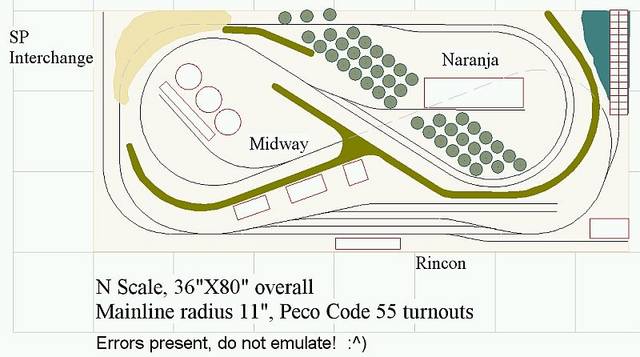I sketched out the plan in 3rdPlanIt and (remarkably) everything fits – but I resisted the urge to correct or improve anything. Twenty years later, some of the details are a little hazy anyway. The overall track locations were suggested by a layout I had seen in an NTRAK publication, which had a sort of a hilly pretzel overcrossing configuration separated by a backdrop from a narrow yard area along one long edge. Benchwork was to be a hollow core door. I had only just started thinking about the hobby again after a long time away and was considering N scale for the first time.
I see a number of obvious things I would do differently today. The stub-ended yard tracks should point in the opposite direction, at least given where the interchange connects and where "Midway" is located. I think I may have imagined this as a shortline that would work the interchange, build a train, run out to Midway and Naranja, then runaround and return (or was it the other way around?). Too many tracks are parallel to the edges of the benchwork, and the model railroad cliché of "an industry track in every corner" is well-represented.
Hidden or secluded sections completed a continuous run and the roughly 2% grade should have been workable. I don't remember what I was thinking of calling it, but the "Rincon Northern" might have been appropriate (the California coast runs roughly East-West in the area). I also don't recall if I simply wasn't thinking of staging at that point or had purposely left it out in favor of the shortline-with-interchange idea.
This little plan was never built. I became involved with a friend's layout based on the Santa Maria Valley Railroad (see Model Railroad Planning 2004 or view the layout plan online here) and my own interests turned to more prototype-inspired designs. Looking back, I think it would have been a great boost for my own modeling if I had taken the time to build and operate this simple little project, even with the flaws. In any case, it was fun to revisit a past infatuation. [And a great way to procrastinate on the clean-up I was supposed to be doing the day I rediscovered this track plan.]
 Speaking of firsts, I was enjoying Gillian Welch's album Time (the Revelator) last week. Her haunting bluegrass/folk/alt-county style with musical partner David Rawlings is well displayed in this album, which includes the slightly melancholy reminiscence "My First Lover". Welch might be best known for her work on the soundtrack to the movie Brother, Where Art Thou, but her music is a very intriguing mix and not limited to old-timey tunes. Rawlings adds sparse but moving fills and creative leads on acoustic guitar that build the atmosphere of each tune. Great record!
Speaking of firsts, I was enjoying Gillian Welch's album Time (the Revelator) last week. Her haunting bluegrass/folk/alt-county style with musical partner David Rawlings is well displayed in this album, which includes the slightly melancholy reminiscence "My First Lover". Welch might be best known for her work on the soundtrack to the movie Brother, Where Art Thou, but her music is a very intriguing mix and not limited to old-timey tunes. Rawlings adds sparse but moving fills and creative leads on acoustic guitar that build the atmosphere of each tune. Great record!
